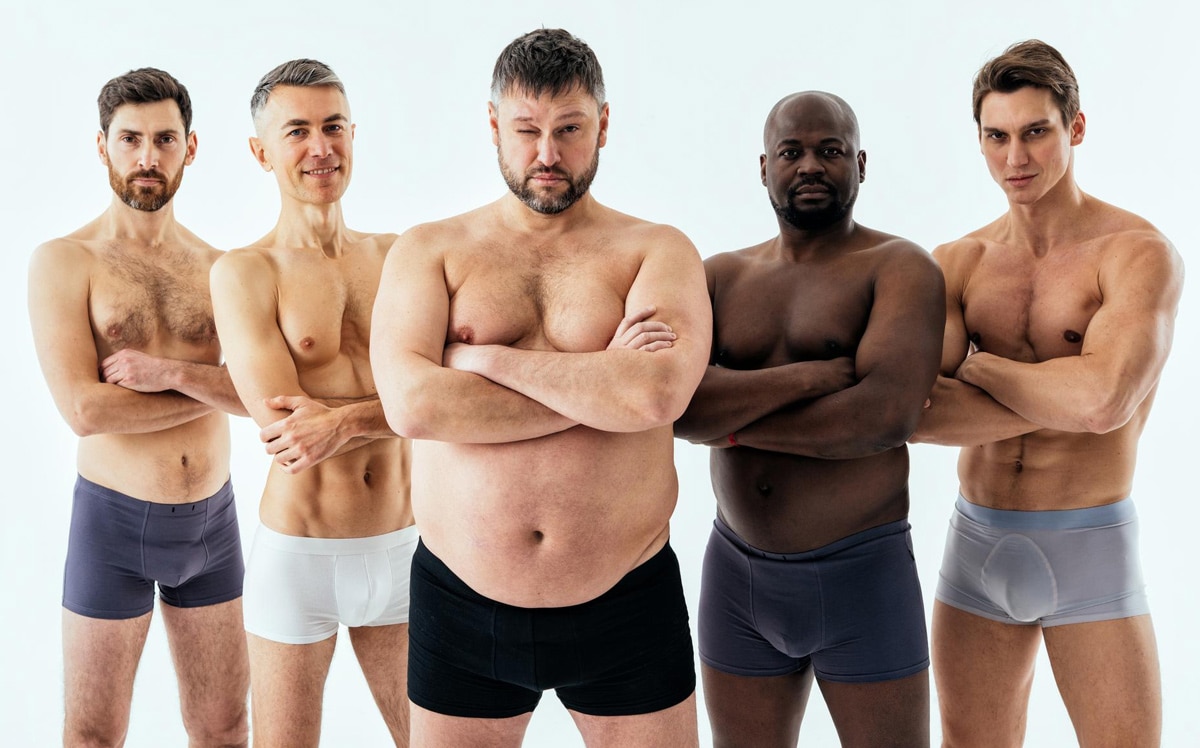Ever wondered why some people bulk up easily at the gym while others can run for miles without tiring? A lot of it comes down to our body types. Everyone’s built differently; learning these differences can be a game-changer for your fitness journey. In this post we will explore the male body types, offering insights into how recognizing your unique body shape can influence your workout and diet plans. Get ready to find out how to work with your body, not against it, to achieve your health and fitness goals.

Contents
What Are The Different Male Body Types?
The different male body types are generally categorized into three main groups: ectomorph, mesomorph, and endomorph. Each type has its own set of characteristics that can influence how you respond to diet and exercise. Here’s a closer look at each:
1. Ectomorph:
Physical Characteristics:
- Lean and slender build
- Narrow shoulders and hips
- Low muscle mass and body fat
- Long limbs relative to torsoFast metabolism
Weight Gain: Ectomorphs often struggle to gain weight due to their fast metabolism, which burns calories quickly. They may also have a smaller appetite than other body types.
Muscle Building: Building muscle can also be challenging for ectomorphs. They may need to focus on a combination of weight training and a high-calorie diet to see significant muscle growth.
Benefits: Ectomorphs naturally have low body fat and tend to have good endurance for activities like long-distance running.

2. Mesomorph:
Physical Characteristics:
- Naturally muscular and athletic build
- Broad shoulders and narrow waist
- Responds well to weight training
- Moderate metabolism
Muscle Building: Mesomorphs have a genetic advantage for building muscle mass and tend to see results quicker with weight training programs.
Weight Gain/Loss: Mesomorphs typically gain muscle and lose fat relatively easily compared to other body types. They can find a good balance between diet and exercise for body composition goals.
Benefits: Mesomorphs have a naturally athletic build and good potential for excelling in various sports and physical activities.
3. Endomorph:
Physical Characteristics:
- Rounder body shape with wider waist and hips
- Higher body fat percentage
- Slower metabolism
- May store fat more easily
Weight Gain/Loss: Endomorphs tend to gain weight more easily than other body types due to their slower metabolism. Losing weight and managing body fat often requires a stricter diet and consistent exercise routine.
Muscle Building: While building muscle is possible for endomorphs, it may take more effort compared to mesomorphs. A combination of strength training and a balanced diet is key.
Benefits: Endomorphs often have naturally higher strength due to their body composition. They can achieve a healthy physique through a dedicated diet and exercise.
What Does Your Body Type Truly Mean?
The concept of body types, also known as somatotypes, can be a helpful starting point for learning your body’s natural tendencies, but it shouldn’t be taken too literally. Here’s a breakdown of what your body type “truly” means:
Somatotypes: A Spectrum, Not Absolutes
The three main categories (ectomorph, mesomorph, endomorph) represent a spectrum, not strict categories. Most people are a mix of two or even all three types. You might have an ectomorph build with a mesomorph’s metabolism, for instance.
Focus on Health, Not Labels
Regardless of your somatotype, prioritizing a healthy lifestyle is key. This means eating a balanced diet rich in fruits, vegetables, and whole grains while getting regular exercise you enjoy.
Genetics and Individuality
Somatotypes don’t take into account factors like ethnicity or genetics, which influence muscle distribution, fat storage, and bone structure. Your body is unique!
Changeable Over Time
Somatotypes aren’t set in stone. Through consistent exercise and a healthy diet, you can significantly alter your body composition. An ectomorph can build muscle, and an endomorph can lose weight and reduce body fat percentage.
Use Your Somatotype for:
- Exercise Selection: Learning your somatotype can help you choose exercise programs that optimize results.
- Realistic Goals: Knowing your body’s tendencies helps set achievable goals for weight management or muscle gain.
- Positive Body Image: Somatotypes can help you appreciate your strengths and work towards a healthy physique that suits you.
How to Improve Your Body Composition?
Improving your body composition, which refers to the ratio of muscle mass to fat mass in your body, involves a two-pronged approach: diet and exercise. Here’s a breakdown of key strategies for each:

Diet:
- Calorie Balance: For most people aiming to improve body composition, creating a slight calorie deficit is key. This means burning more calories than you consume, which forces your body to tap into stored fat for energy. However, significant calorie restriction can be counterproductive, so consult a doctor or registered dietitian for personalized guidance.
- Macronutrients: Focus on a balanced intake of macronutrients: protein, carbohydrates, and healthy fats. Protein helps build and repair muscle tissue, while carbohydrates provide energy and healthy fats support hormone regulation and satiety.
- Nutrient-Dense Foods: Prioritize whole, unprocessed foods like fruits, vegetables, whole grains, and lean protein sources. These foods are packed with essential vitamins, minerals, and fiber that support overall health and metabolism.
- Minimize Processed Foods: Limit processed foods, sugary drinks, and unhealthy fats. These foods are often high in calories and low in nutrients, hindering your body composition goals.
Exercise:
- Strength Training: Strength training is crucial for building and maintaining muscle mass. Muscle burns more calories at rest than fat, so increasing muscle mass boosts your metabolism and helps you burn more calories throughout the day. Focus on compound exercises that work multiple muscle groups for maximum efficiency.
- Cardio: While cardio isn’t essential for muscle building, it plays a significant role in burning calories and overall fitness. Aim for moderate-intensity cardio most days of the week, and consider incorporating high-intensity interval training (HIIT) for an extra fat-burning boost.
- Consistency: Consistency is key for long-term success. Aim for regular exercise sessions, even if they’re shorter in duration. Gradually increase the intensity and duration of your workouts as you get fitter.
- Proper Form: Always prioritize proper form during exercise to maximize results and minimize injury risk. Consider consulting a trainer for guidance, especially if you’re new to strength training.
Improving body composition is a journey, not a quick fix. Be patient, and consistent, and celebrate your progress along the way. Consulting a healthcare professional or registered dietitian can help you create a personalized plan that considers your individual needs and goals.
Frequently Asked Questions
What are the three main male body types?
The three main male body types are ectomorph, mesomorph, and endomorph. Ectomorphs are typically lean and struggle to gain weight as either body fat or muscle. Mesomorphs can easily gain and lose weight, usually muscular without trying too hard. Endomorphs tend to gain weight easily and have a higher body fat percentage, making it harder to lose weight.
How can I identify my male body type?
To identify your male body type, look at your natural physique and how your body responds to food and exercise. Ectomorphs are usually slender and have a fast metabolism. Mesomorphs have a naturally athletic build and gain muscle easily. Endomorphs are broader and have a sturdy build, tending to store more fat. Your lifestyle, diet, and exercise habits can also influence your body type over time.
Can my body type change over time?
Yes, your body type can change over time due to lifestyle, diet, exercise habits, and age. While your genetic predisposition to one of the body types won’t change, you can alter your physique through targeted exercise and nutrition. For example, an ectomorph can gain muscle mass through strength training and a protein-rich diet, while an endomorph can reduce body fat through regular cardio and a controlled diet.

Hello, I’m Ravindra. Over the years, I’ve immersed myself deeply into the world of fitness and health, transforming both my body and mind. Writing has allowed me to share my journey, insights, and expertise with those just starting out and seasoned fitness enthusiasts alike. Beyond just routines and diets, I believe in inspiring others to adopt a holistic approach to well-being.
